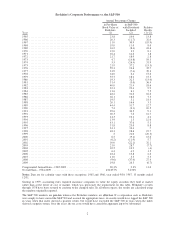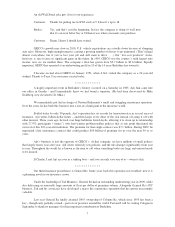Berkshire Hathaway 2009 Annual Report Download - page 7
Download and view the complete annual report
Please find page 7 of the 2009 Berkshire Hathaway annual report below. You can navigate through the pages in the report by either clicking on the pages listed below, or by using the keyword search tool below to find specific information within the annual report.We pay a steep price to maintain our premier financial strength. The $20 billion-plus of cash-
equivalent assets that we customarily hold is earning a pittance at present. But we sleep well.
• We tend to let our many subsidiaries operate on their own, without our supervising and
monitoring them to any degree. That means we are sometimes late in spotting management
problems and that both operating and capital decisions are occasionally made with which Charlie
and I would have disagreed had we been consulted. Most of our managers, however, use the
independence we grant them magnificently, rewarding our confidence by maintaining an owner-
oriented attitude that is invaluable and too seldom found in huge organizations. We would rather
suffer the visible costs of a few bad decisions than incur the many invisible costs that come from
decisions made too slowly – or not at all – because of a stifling bureaucracy.
With our acquisition of BNSF, we now have about 257,000 employees and literally hundreds of
different operating units. We hope to have many more of each. But we will never allow Berkshire
to become some monolith that is overrun with committees, budget presentations and multiple
layers of management. Instead, we plan to operate as a collection of separately-managed medium-
sized and large businesses, most of whose decision-making occurs at the operating level. Charlie
and I will limit ourselves to allocating capital, controlling enterprise risk, choosing managers and
setting their compensation.
• We make no attempt to woo Wall Street. Investors who buy and sell based upon media or analyst
commentary are not for us. Instead we want partners who join us at Berkshire because they wish
to make a long-term investment in a business they themselves understand and because it’s one that
follows policies with which they concur. If Charlie and I were to go into a small venture with a
few partners, we would seek individuals in sync with us, knowing that common goals and a shared
destiny make for a happy business “marriage” between owners and managers. Scaling up to giant
size doesn’t change that truth.
To build a compatible shareholder population, we try to communicate with our owners directly
and informatively. Our goal is to tell you what we would like to know if our positions were
reversed. Additionally, we try to post our quarterly and annual financial information on the
Internet early on weekends, thereby giving you and other investors plenty of time during a
non-trading period to digest just what has happened at our multi-faceted enterprise. (Occasionally,
SEC deadlines force a non-Friday disclosure.) These matters simply can’t be adequately
summarized in a few paragraphs, nor do they lend themselves to the kind of catchy headline that
journalists sometimes seek.
Last year we saw, in one instance, how sound-bite reporting can go wrong. Among the 12,830
words in the annual letter was this sentence: “We are certain, for example, that the economy will
be in shambles throughout 2009 – and probably well beyond – but that conclusion does not tell us
whether the market will rise or fall.” Many news organizations reported – indeed, blared – the first
part of the sentence while making no mention whatsoever of its ending. I regard this as terrible
journalism: Misinformed readers or viewers may well have thought that Charlie and I were
forecasting bad things for the stock market, though we had not only in that sentence, but also
elsewhere, made it clear we weren’t predicting the market at all. Any investors who were misled
by the sensationalists paid a big price: The Dow closed the day of the letter at 7,063 and finished
the year at 10,428.
Given a few experiences we’ve had like that, you can understand why I prefer that our
communications with you remain as direct and unabridged as possible.
************
Let’s move to the specifics of Berkshire’s operations. We have four major operating sectors, each
differing from the others in balance sheet and income account characteristics. Therefore, lumping them together,
as is standard in financial statements, impedes analysis. So we’ll present them as four separate businesses, which
is how Charlie and I view them.
5




















